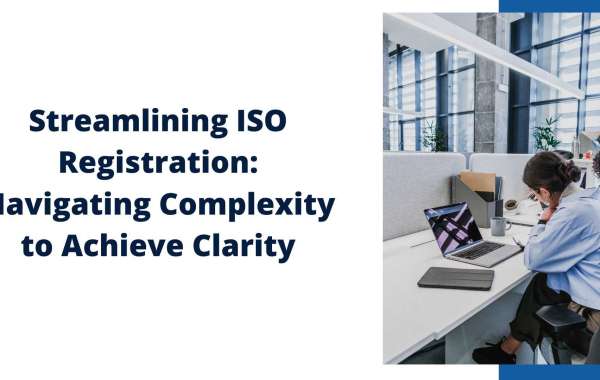In today's dynamic business landscape, obtaining ISO certification has become a pivotal step for companies aiming to demonstrate their commitment to quality, efficiency, and continual improvement. However, the process of ISO registration can often be perceived as complex and daunting, deterring many organizations from pursuing it. With the advent of digital technology, there's a growing opportunity to simplify and streamline the ISO registration process, making it more accessible and manageable for businesses of all sizes.
Understanding the Complexity
ISO (International Organization for Standardization) certification is a globally recognized standard that signifies a company's adherence to specific management systems, such as quality management (ISO 9001), environmental management (ISO 14001), or information security management (ISO 27001). Achieving ISO certification involves rigorous assessment of organizational processes, documentation, and compliance with international standards.
Traditionally, the ISO registration process has been perceived as complex due to several factors:
Documentation Requirements:
Companies must prepare extensive documentation outlining their processes, procedures, and policies to demonstrate compliance with ISO standards. This documentation process can be time-consuming and overwhelming, particularly for organizations with limited resources.
Audit Procedures:
ISO certification requires thorough audits conducted by accredited certification bodies to assess compliance. These audits involve on-site visits, interviews, and reviews of documentation, adding another layer of complexity and potential disruption to daily operations.
Resource Allocation:
Obtaining ISO certification demands significant resources in terms of time, manpower, and financial investment. Small and medium-sized enterprises (SMEs), in particular, may struggle to allocate resources effectively to navigate the certification process.
Navigating Standards:
Understanding the intricacies of ISO standards and ensuring alignment with organizational goals and processes can be challenging, especially for businesses with diverse operations or operating in highly regulated industries.
Simplifying the Process Through Digital Solutions
The digital transformation sweeping across industries presents an opportunity to simplify the ISO registration process and make it more accessible to organizations worldwide. By leveraging technology and innovative solutions, companies can overcome the barriers associated with ISO certification:
Online Documentation Platforms:
Utilizing cloud-based documentation platforms allows organizations to centralize and streamline their ISO documentation process. These platforms offer templates, version control, and collaboration features, facilitating the creation, management, and maintenance of documentation in a more efficient and organized manner.
Virtual Audits:
Digitalization enables the conduct of virtual audits, reducing the need for physical presence and minimizing disruptions to business operations. Through video conferencing, document sharing, and remote access to systems, auditors can assess compliance remotely, providing a more flexible and cost-effective approach to certification.
Automation and Compliance Tools:
Automation tools can simplify compliance tasks by automating document control, corrective action management, and monitoring of key performance indicators (KPIs). These tools not only streamline processes but also enhance accuracy and consistency in maintaining compliance with ISO standards.
Education and Training Resources:
Digital platforms offer a wealth of educational resources, training modules, and interactive tools to help organizations understand and implement ISO standards effectively. Online courses, webinars, and virtual workshops provide accessible and cost-efficient training options for employees at all levels.
Navigating the Path to Clarity
While digital solutions offer tremendous potential to simplify the ISO registration process, it's essential to approach the journey with clarity and strategic planning:
Alignment with Organizational Goals:
Before embarking on the ISO certification journey, organizations should ensure alignment between ISO standards and their strategic objectives. Identifying the areas where ISO certification can add value and drive improvement is crucial for maximizing the benefits of the process.
Engagement and Commitment:
Achieving ISO certification requires commitment from all levels of the organization. Leadership support, employee engagement, and a culture of quality and continuous improvement are essential factors in navigating the certification process effectively.
Continuous Improvement:
ISO certification is not a one-time achievement but a journey of continual improvement. Organizations should embrace a mindset of ongoing evaluation, adaptation, and enhancement of processes to maintain compliance and drive excellence beyond certification.
Partnering with Experts:
Engaging with experienced consultants, auditors, and technology providers can streamline the ISO registration process and ensure successful outcomes. Collaborating with trusted partners who understand the nuances of ISO standards and digital solutions can expedite the path to certification.
Note: You Can Apply for ISO 50001 Certification Through ISO Portal
Conclusion
In an increasingly competitive and quality-driven market, ISO certification serves as a valuable differentiator for businesses seeking to demonstrate their commitment to excellence. By leveraging digital solutions and strategic approaches, organizations can navigate the complexity of ISO registration and attain clarity in their quest for quality, efficiency, and continual improvement. With the right tools, mindset, and support, the journey from complexity to clarity in ISO certification is within reach for organizations of all sizes and industries.







